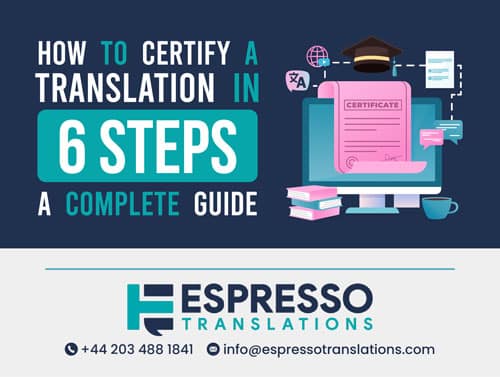To get a document officially translated, you must first understand the exact requirements of the requesting entity in the country in which you need to use it. Then, your documents should be translated and certified by a professional. This might be either a reputable translation company or a freelance certified translator.
How do I get a document officially translated? How does certification work?
You need to entrust your documents to a translation provider with proven experience and accuracy, as even minor mistakes or discrepancies can invalidate your documents and have serious legal implications. An accurate translation is not just about language proficiency; it requires a deep understanding of both the languages involved and their respective cultures, as well as a thorough knowledge of the subject matter.
It’s vital to choose based on what meets government officials’ requirements in the target country, otherwise, you may incur unnecessary costs or delays.
Bear in mind that certified translations usually cost more than standard translations, as the translator assumes legal responsibility for the accuracy of the translation.
The certification process is another crucial element to consider when seeking an official translation. Certification requirements vary from country to country. Either the requesting entity can offer guidance, or you can seek assistance from a certified translation agency, which can usually advise of the official requirements for a given country or entity.
For example, in the UK, a certificate of translation accuracy signed by the translator is sufficient. In countries such as Italy, however, the translation needs to be sworn in front of a public official in order to be officially recognised.
1. Understand the need for certified translations
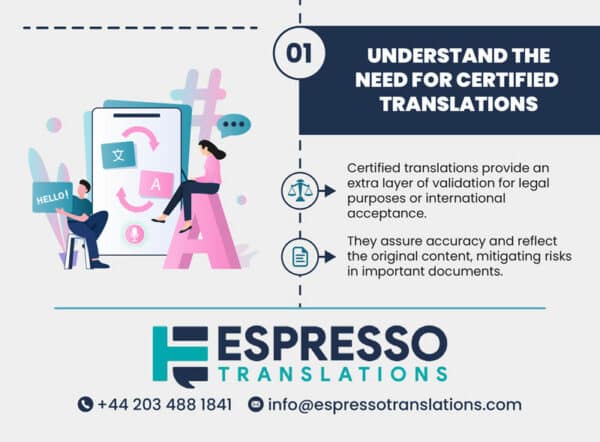
Certified translations, namely translations with a higher level of authentication, are often needed for legal purposes or international acceptance. They add an extra layer of validation that assures the receiving party – be it government bodies, universities, or foreign public entities – that your document is accurately translated and truthfully reflects the original content.
Imagine you’re sending important company contracts overseas. A misinterpretation could lead to significant legal implications and even financial losses. A certified translation helps mitigate these risks by providing an attestation of accuracy from a qualified professional translator or agency who assumes responsibility for the translated content.
When comparing certified vs non-certified translations, remember this: a certified translator will go through their work with a fine-toothed comb to ensure every single word is translated accurately, and this is the reason why many foreign entities only accept certified translations.
2. Choose the right certified translation service
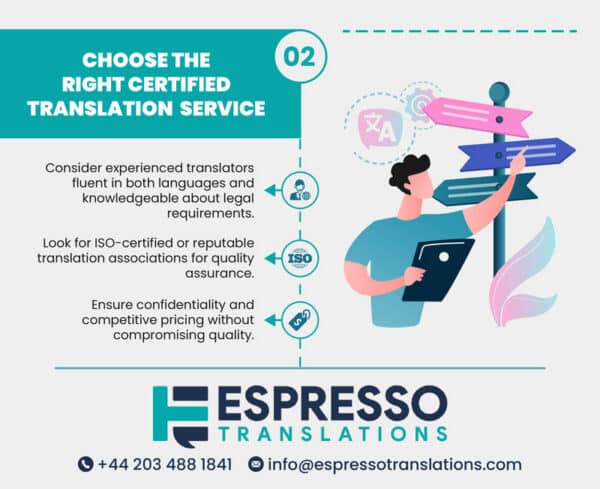
The four key factors you should consider when choosing a certified translation service, are listed below:
- Translation quality: Ensure that the translation service has experienced translators who are fluent in both languages involved, not just in terms of vocabulary but also in grammar and idiomatic expressions. Consider a translation company that is ISO-certified or a member of a translation association such as the ATC, the ITI or the American Translators Association.
- Certification knowledge: Be sure to discuss your translation requirements with the translator or translation company in detail. Try to get a feel for whether they understand the official and legal translation requirements for the country you need to use the documents in. You can even ask to see an example of a translation certification and check with the requesting entity that it’s sufficient for purpose.
- Confidentiality concerns: You should be confident that your sensitive data will remain secure and confidential throughout the process, especially as you are sharing personal information.
- Cost implications: While cost shouldn’t be your only concern when looking for quality translations, it’s still an important factor to consider. Look for providers who offer competitive prices without compromising on quality or confidentiality.
3. Ask for a quote and delivery time
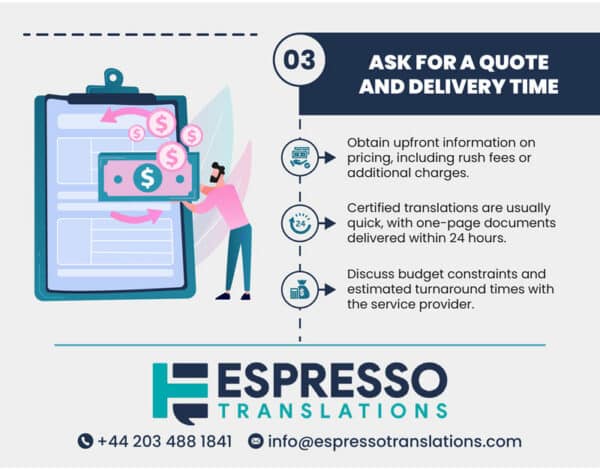
Pricing can vary significantly from company to company, so be sure to get all of the information upfront, in particular, if there are any additional costs such as rush fees for urgent deliveries or additional charges for formatting. Other price-influencing factors are complexity, urgency, formatting, and any specialisation required.
Unlike sworn translations, the process for certified translations is usually pretty quick, with the translator able to provide certified copies of one-page documents within 24 hours. This is very important if you have a specific deadline for submitting the translation, such as for citizenship and immigration services.
Don’t shy away from discussing your budget constraints with the translation service provider. They may be able to offer lower-cost solutions or flexible payment terms. Likewise, ask them about their process for estimating turnaround times. How are they calculated? Do they account for unexpected delays?
4. Submit an electronic copy of your documents to your translation provider
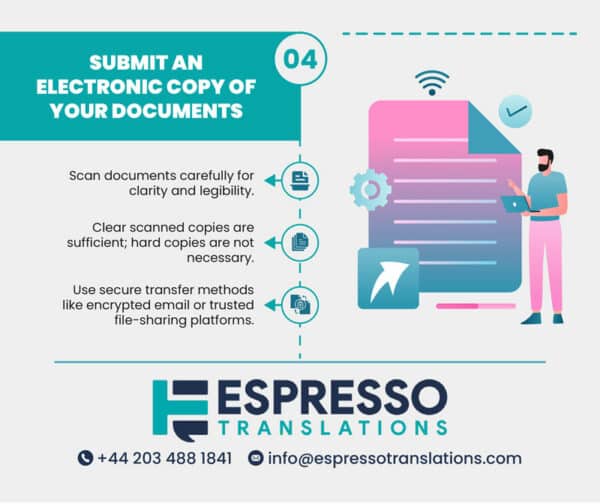
Scan each document carefully making sure that everything is clear and legible. If a document is not legible, the translator may refuse to certify the translation as they cannot ensure that it is a true and accurate depiction of the original. The translator does not need hard copies of the original document; a clear scanned copy will suffice.
When sending files electronically, ensure you use a secure transfer method such as encrypted email or a trusted file-sharing platform such as WeTransfer, One Drive or Google Drive. This will protect your documents from being intercepted by malicious third parties.
5. Get your translation certified or notarised
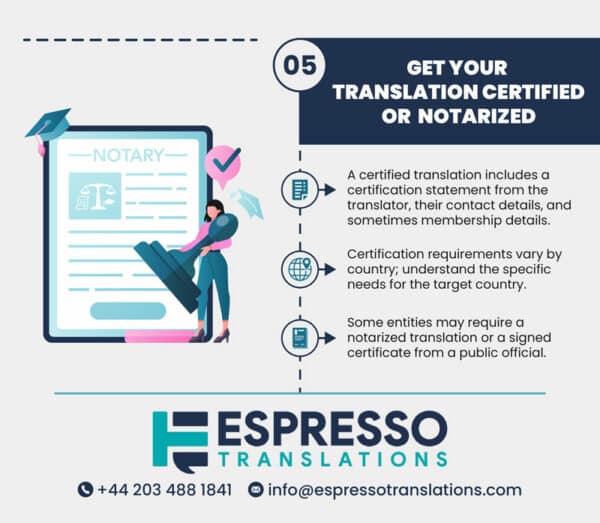
A certified translation will include a certification from the translator that the document has been translated by them, attest to the quality of the translation with a certification statement such as “this is a true and accurate translation of the original” and will contain their name and contact details.
Sometimes, it will also include details of their membership of a translation association such as the ATC in the UK or the ATA in the U.S, however, this is not always necessary. The terms certified or notarised translation may sound daunting, but getting your translation certified is a vital step that ensures the quality of your foreign language document is recognized and accepted by international entities.
6. Review and verify the certified translation
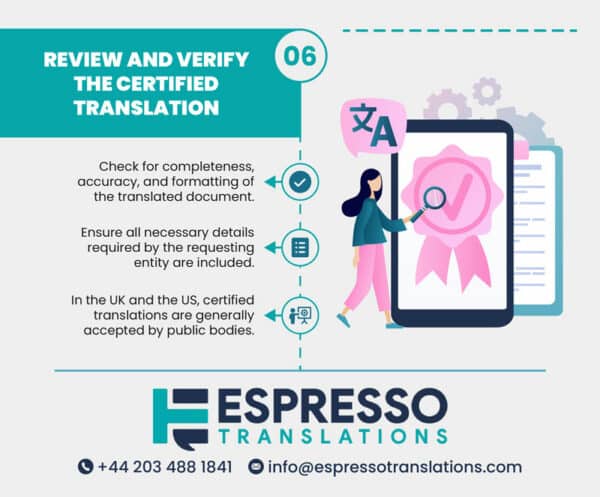
Once you have received your file, have a quick check-over to ensure the translation is complete and accurate. Look at things like the spelling of names and surnames, addresses and dates of birth. Also, ensure the formatting is an accurate representation of the original.
Depending on the level of certification, make sure the attestation contains all of the details required by the requesting entity. In the UK and the U.S, a certified translation is usually accepted by public bodies such as the Foreign and Commonwealth Office, Passport Office or USCIS.
Some entities may request a notarized translation, so make sure that the notary’s seal and stamp are present.
For some civil law countries, a certified translation won’t suffice and you may need a signed certificate from a public official. Check what is required for your documents before you submit them for translation.
Also Read: What is the difference between certified translation and sworn translation?
FAQ
What are the British Home Office requirements for certified translations?
The British Home Office requires that the certified translation is comprised of the translator’s contact details (name, address, email & phone number), a signed statement that verifies that it’s a human translation of documents and is complete and accurate, and an official seal or signature.
What does the term “certificate of accuracy” mean?
This term refers to an official document that vouches for the correctness and completeness of a translation. The certificate’s primary aim is to confirm that the translated text accurately reflects the original document’s content.
Can I get a certified translation online?
It’s entirely possible to get your documents in other languages with official approval online.
Can anyone certify a translation UK?
A language services provider or a certified linguist can provide a certification of accuracy. Certification professionals follow a stringent certification process that validates each translation for correctness and completeness. Also, reputable translation agencies have the capacity to provide certificates of accuracy for translations done on their behalf.
Do translators need to be certified in UK?
Although there is no specific title of “certified translator” in the UK, British authorities generally accept certifications from translators who are experienced and qualified members of a recognized professional body, such as the Chartered Institute of Linguists (CIoL) or the Institute of Translation & Interpreting (ITI). These organizations have strict criteria for membership, typically involving professional qualifications and experience, thereby ensuring that their members can provide reliable and high-quality translation services.
Do I need to find a certified translator?
While it’s not always mandatory to hire a certified translator, doing so can give you that extra assurance of both language proficiency and translation accuracy. Certified linguists have gone through extensive training and testing to prove their skill in translating from one language to another.
If, however, your document needs to be submitted for official purposes, such as to government offices, you will need to find a certified translator.
When do I need certified translation services?
You will need certified translation services in many cases, such as International Legal Disputes, academic applications and immigration processes.
Can I use Google Translate for certified translations?
Google Translate and other machine translation tools or AI do not provide a certification of translation. While they can provide a general gist of texts in many languages, accuracy doesn’t measure up to professional standards and only human translations will be accepted by public entities and institutions.
Can I do a certified translation myself?
Self-certification is usually not accepted for legal documents, proceedings or for organisations such as the FCO.
With professional certification, you’re paying for expertise and peace of mind that your document will be accepted.

